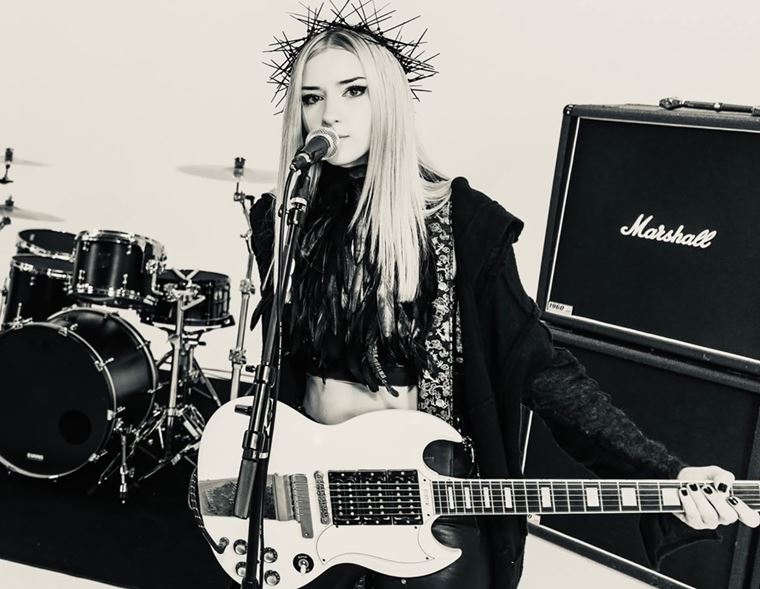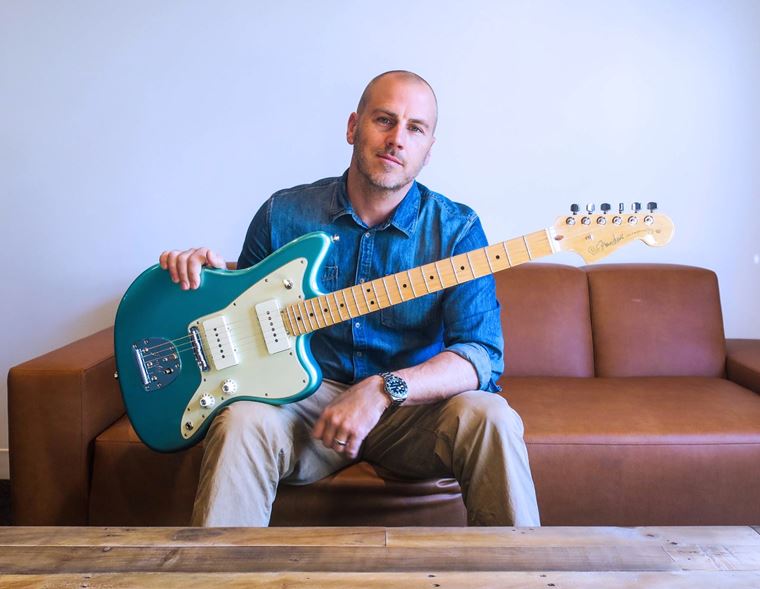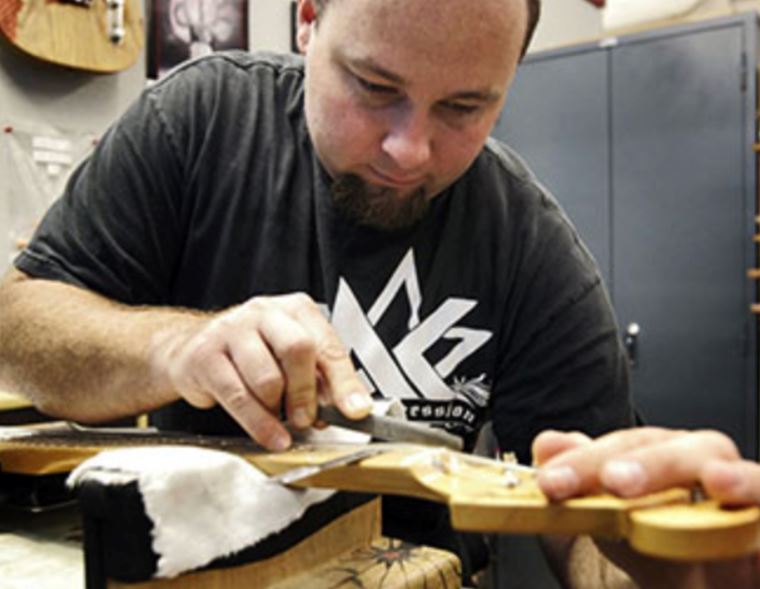The Definitive Story of the Ibanez JEM, as Told by STEVE VAI!
Published on 23 August 2024
"It all started when I discovered what a whammy bar was."
The Ibanez JEM is a rare bird indeed. The Monkey Grip. The Tree of Life. The Lion’s Claw. The disappearing Pyramids. The day-glo finishes. One of our all-time favourite guitars here at guitarguitar, the JEM defies typical guitar industry logic. A signature guitar that is a fairly radical update on the Fender Strat (to the point where you’d say the two were almost unrelated), the JEM is a deeply individual and eccentric instrument.
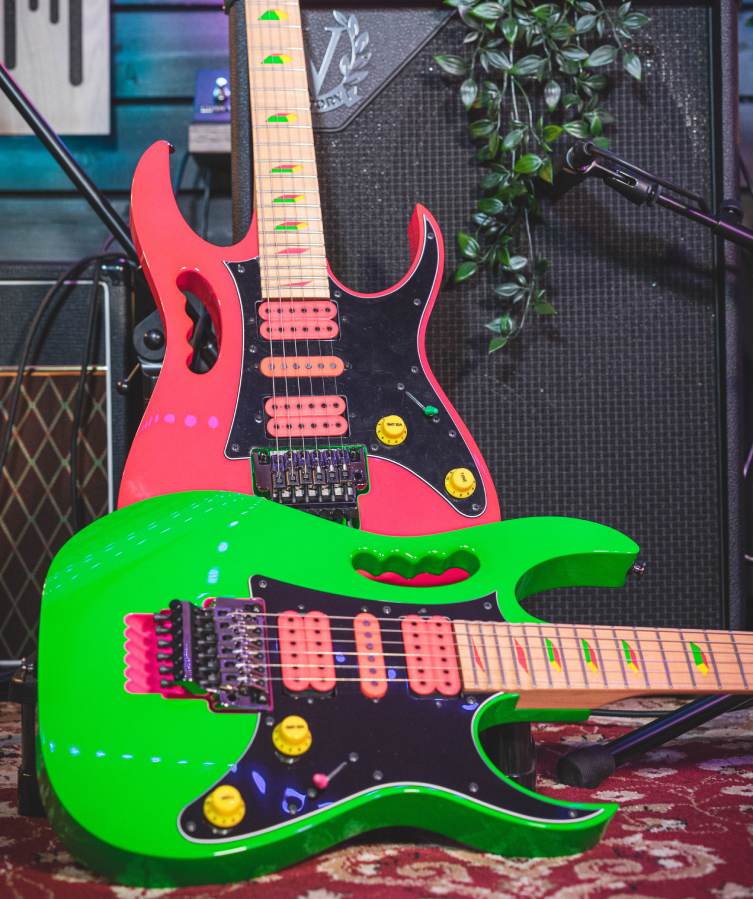
For such an uncompromising guitar to make it into production at all is quite the achievement (no matter how beautiful it might be), when guitarists - even in the crazy 80s - are normally relatively conservative in their taste.
But the JEM didn’t just get a release; it has remained in constant production since that release, way back in 1987! It’s one of a very, very few non-50s guitar designs that have become legitimate successes, and has since gone on to enjoy a large number of special editions, anniversary releases and even a sideways update in the form of the Ibanez PIA.
Central to all of this is of course Steve Vai. The megastar guitar wizard and composer is inseparable from the JEM; indeed, it’s the ultimate expression of a guitar dream he took years to design. Such an otherworldly talent requires an instrument that’s up to the task, and with his JEMs, Vai is able to perform at his peak.
We’ve been celebrating Ibanez this month at guitarguitar as part of our 20th Anniversary celebrations, and I wanted to do something to celebrate the JEM. It’s one of Ibanez’s most iconic guitars, and it’s linked to one of the greatest players in history. Who wouldn’t want to know more about that? Luckily, I’ve been very privileged to have been able to share a little bit of time with Steve over the years, and since there is literally no one better than he to talk about the JEM, I figured I’d reach out and see if he’d be interested in going through the whole story with me: the Pre-JEM days, the early designs, the release and the legacy.
I knew that he’d soon be rehearsing for the upcoming BEAT tour (check back next week for a little more on that!) so I had to get in quick! Thankfully, Steve was able to free up a little bit of time for us to have a conversation about the JEM. As ever, Steve is a riot to talk to: witty and funny with lots of anecdotes and insights. In this long-form piece, we delve deep into the whole mythos of the JEM, discussing some of the more esoteric features, plus all of the practical ones! You’ll get it all here: the definitive story of the Ibanez JEM, from the man who designed it: STEVE VAI.
I hope you enjoy it!
Contents
The Definitive Story of the Ibanez JEM, as Told by Steve Vai
Alcatraz, Grover Jackson & the Green Meanie
Diamond Dave & The JEM Develops
The Launch of the JEM (and the RG), the Quality of Ibanez
Special JEMS: Floral, Acrylic 20th Anniversary
The Definitive Story of the Ibanez JEM, as Told by Steve Vai
guitarguitar: Steve, thanks so much for joining me again to talk about the JEM. It's Ibanez month for guitarguitar and I wanted to talk about the JEM, I thought: who better than the man himself?
Steve Vai: Sure!
GG: I'm thinking what I'd love to know first is if we go right back to the pre-JEM times and take it from there? From what you were playing to what you were beginning to need from guitars and so on.
SV: Well, if you like I can just kind of tell the whole story as I remember it? Through the years, various people have gone back to dig for various pieces of information and sometimes they've corrected me! (laughs) So I'll give you my account of it!
The Pre-JEM Days
It started when I discovered what a whammy bar was. I was really into Led Zeppelin, that is what woke me up when I was 10 or 11 and I just loved that music. I became enamoured with Jimmy Page.
Of course everything I was trying to absorb was in the Led Zeppelin orbit, so I wanted a Les Paul. There were things I didn't like about a Les Paul, though, you know? They didn't have a whammy bar, they didn't sit properly… But I was very young, so the first guitar I had I got when I was 12 and it was a Teisco Del Rey and it had a whammy bar. And that was fantastic, but then I wanted a black Les Paul so bad and I couldn't afford one, so I bought a cheap knockoff called a Univox.
I went through a couple of hand-me-down guitars from friends, I got an SG, an old SG. But then finally, I purchased my first Strat. I was 16. And I got a 1977 blonde strat that was from Matthew's music at Roosevelt Field. It had a whammy bar, and this was like heaven and a cup. (laughs)
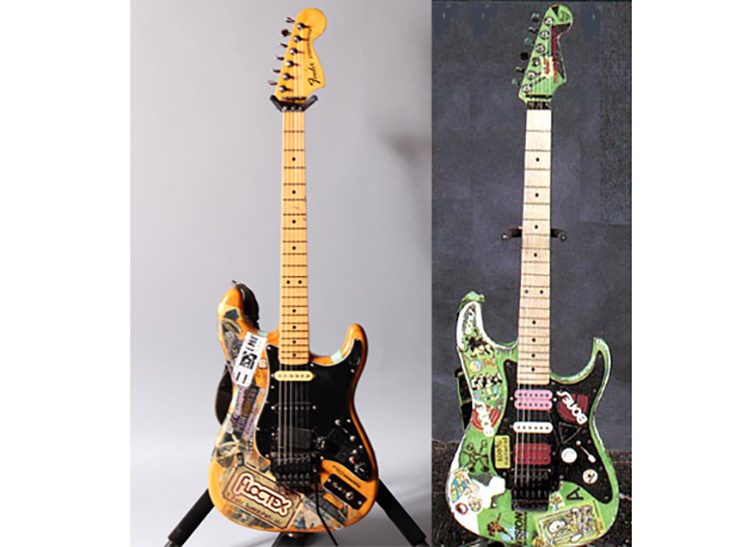
Steve's First Strat, next to the famous Green Meanie!
The only problem with the Strat for me, was: I love the whammy bar, but it didn't sound like rock and roll. It didn't have that thick buttery kind of a sound. Of course, great artists were making it sound great, but me and my high school band? The Strat was a little thin, and I just couldn't get a great sound for rock music.
But that’s all I had, and I used it all through high school and college. I even broke the whammy bar! I used to hold it on with a rubber band! I had a rubber band, I'd wrap it around the post of the whammy bar, you know, and then I'd wrap that around the body and it would just hold the whammy bar in place.
GG: Wow! That’s ridiculous!
SV: Yeah! So then, when I moved to California and started working with Zappa, I was using that Strat, but then I started to realise from working with Frank that you're free to do anything you want with a guitar. I mean, Frank was doing it with everything: music, lyrics, business, technology, and he did it with the guitar. He was very irreverent, he would take like his Jimi Hendrix strat - which was owned by Hendrix and burned in Montreal and given to Frank by a tech, I believe - and he changed the pickups out, he put holes in it and put all these frequency modulators and parametric EQs. And even the pickup caps that had the little holes from where the lighter fluid hit it, you know? They were just like: ‘okay, I don't need those!’
Alcatraz, Grover Jackson & the Green Meanie
So Frank was doing this to guitars, and as it was around that time, I realised you can have custom guitars made, so I had my first few custom guitars built. One was Valdez down on Hollywood Boulevard, and they all had whammy bars and humbuckers and stuff, but they still weren't doing it for me, they still had 22 fret necks and they still were too conventional.
So when I had joined Alcatraz, that Strat just was not cutting it, and I really needed something. So Jimmy Waldo, who was the keyboard player in Alcatraz, took me to his buddy Grover Jackson down at Jackson guitars. Grover was very kind and he turned me on to the Jackson model that was probably the closest kind of thing to what I was imagining I'd like. It had the neck space, it had the whammy bar, it had I think that 24 frets and it was one of the few superstrats. But it had a neck through the body and I just wasn't crazy about that, you know?
They were beautiful instruments - he gave me like three Jacksons and I used them on various things - but it still wasn't quite it. But he did have a sunburst Charvel and that was more along the lines of what I was interested in. It was still kind of limited: it had 22 frets but it was a superstrat, so it had humbuckers and a whammy bar. What I didn't know at the time was that that was his personal guitar: I was under the impression he gave it to me with the other guitars. I'd come to find out later it was actually a loan, but my guitar tech at the time, Patrick Francis - Elwood - he's now the bass player in ZZ Top…
GG: Oh yeah, I know who you mean!
SV: Yeah, he was my tech, he was fantastic. And he did all sorts of crazy things to that guitar: stripped it, painted it day-glow green and put all stickers on it and stuff, but that guitar was really the stepping stone to the JEM because I started to manipulate it to fit more of the kind of thing I was going for.
So one of those things was I carved out the neck so that I could reach the notes. I could never understand why Les Pauls and Stratocasters and many guitars - they give you the frets - but you can't reach them! It just doesn't make sense to me. It's kind of… stupid. So I just carved it out so that my hand fit perfectly and I could play the high notes, but there were only 22 frets. But that guitar, it became the Green Meanie and it was a real workhorse.
"The JEM was built towards those kinds of players who want to really explore their potential. It was built with an expansion in mind. Now, I didn't know I was doing that at the time!"
I used it all throughout Alcatraz, It's all over Passion & Warfare, and I used it on Eat ‘Em & Smile a lot. I used it on the Eat ‘Em & Smile tour, and one of the things I did to it - which I did to a guitar previously in an attempt to try to get closer to what I wanted - was the whammy bar. Most guitars at the time that had whammy bars had the potential to go a little sharp, so you get this real whammy kinda (makes sound of pitch fluctuating), you know, the fundamental note, and then a little sharper, a little flatter. Most of them would really dive down, but I wanted to go really high. And I couldn't figure out why it wouldn't go high, because at this point, we had the Floyd Rose.
I just looked at it and I realised that in the back where the block is, it was just being stopped by the wood. So I just chiselled it out! And next thing you know, I had this huge floating trem! As soon as I did that on the first guitar, I recorded The Attitude Song, which displays that, because that's what I wanted but no guitar did it that I knew of.
So, elements of what ended up becoming the JEM were forming through a period there.
Diamond Dave & The JEM Develops
But then with Dave Roth and the preparation for the first tour, I knew I needed some real guitars. Substantial guitars that really fit my idiosyncrasies, but nobody was making it.
So I decided - and I think this came from my years with Frank, to be fearless in regard to pursuing what it is that you want - I went to this little guitar shop in Hollywood called Performance Guitar and they did great work. Kuni was the guy there, I think he's still there and he's still got the shop. I went in there way back when I was like 23 or 24 and I just designed a guitar with them, you know? Well, he gave me a body and I kind of reshaped it a little bit so that it fit my hands. I knew I wanted a 24 fret neck. I knew I wanted to be able to pull up on the bar, so that whole thing was shaved out. There were some simple things, you know? Some that were unique at the time, like having a 24 fret neck with that kind of cutaway and a floating tremolo: they didn't exist!
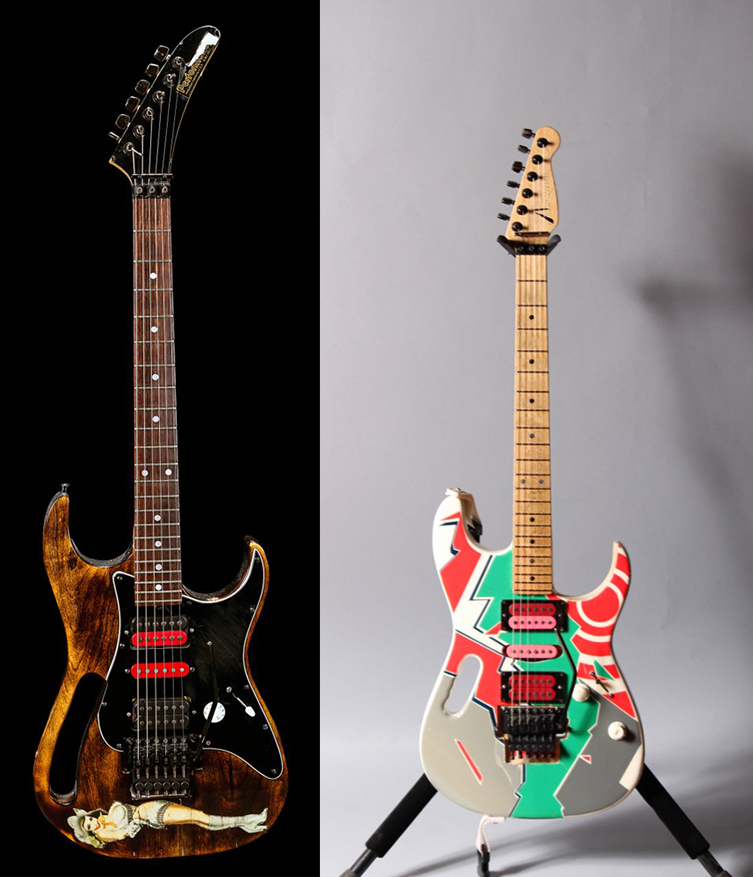
One of Steve's Performance guitars next to Tom Anderson's pre-JEM build!
But also what was unique - at least I'm told all these things - was the pickup configuration. The thing that I did love about the Strat was, when you have the two single coils engaged in the neck and the middle position, you get that 'tubey' kind of a Strat sound. I always loved that, but I never was really a fan of the single coil by itself. For rock and roll, you know?
So, I developed this pickup configuration that had two humbuckers and a single coil in the middle. But it's the switch: it's the five-position switch that was unique, because in the first position, you get the neck pickup and in the second position, it splits the coil on the middle and the neck, so you get two single coils for that tubey Strat sound. Now, it doesn't sound exactly like a Strat because there's a lot of other things that go into making a Strat sound like a Strat, but you definitely get that you can hear that tubey-ness.
And then you got the middle position, which I can assure you, I never use (laughs). Then you’ve got the middle position and the bridge position, which is where the switch is wired to make those two single coil. You got full on humbucker in the bridge position. So that really was working great. As a matter of fact, it hasn't changed for me in 40 years.
And there were a couple of simple changes. You know, the volume knob was too close, I kept hitting it, so I just moved it down a little bit. The input jack: I could never understand why Fenders had input jacks that if you step on the cable, they come out. Of course, you can put your cable through the strap, but you know, then you've got this big thing sticking out. So I just thought: put it at an angle!. It was stupid, but it made sense and it worked.
So I was looking for things that just made things easier for me and had within them what I really wanted. And I like the body shape because I mean, I liked Strats, but there's something very pedestrian looking about them. I thought that the JEM was a lot sexier. It's got sharper edges, it's a little bit bigger, and it sits really well. I was so thrilled, and I had Performance guitar make four of these guitars.
"When the time came to develop a pickup for the White JEM, also at that time I was very much into Southern California biker culture. I didn't have a car but I had seven Harleys!"
Now Elwood was a part of it all too, he was kind of overseeing, and he constructed those first JEMs and swapped out certain things until it was just right.
So when I had these four guitars, I mean, it was paradise! I was ready, you know? I figured ‘I got my guitars!’ Then I started to become popular, because I was with Dave Roth. When that happens, the guitar companies are interested in having you play their instrument because it's great promotion. So I was getting approached by all of the companies, which was very nice, but they didn't have anything for me. I had the JEM. I just thought, thank you, but no thanks, you know? Then I realised that if I did an endorsement deal with somebody, I would be getting their service, I would be getting them to make guitars for me, and also I'd be able to change them. So I thought it might be a good idea to at least explore it.
There was something a little odd to me about doing endorsements, because I had done them before that. When I was in Alcatraz, there was a company called Aria Pro. At that age and that kind of economics bracket, I'm just like, ‘Free? Okay, I’ll take it!’ But then you start recognising the responsibilities of endorsing a product, and what that entails. And I realised back then that I was going to stand clear of endorsing things.
But you know, that changed because I just met so many great companies, like I've been with DiMarzio forever, Ernie Ball… I mean, these people are like family.
The Challenge
And so various companies were interested. And I thought, okay, here's the guitar that I play. And here's the specs. If you can make me this guitar, whoever makes me the best one… I didn't care if it was Fender or Gibson or any of the others. Kramer was popular at the time. And Tom Anderson, I really liked his instruments, he just made such great instruments, they were just a cut above everything. And, as a matter of fact, Tom Anderson made me one. But inevitably I would get these guitars back and they just weren't the guitar that I gave them. Tom came close - he put a handle in it - but it was still…it wasn't the JEM, but it was nice, and I used it a lot on Passion & Warfare.
All the other companies, they sent me their guitar with my name on it and a couple of little tweaks, because that's really what a signature guitar usually is - not all the time - but usually it’s a brand of guitar that already has an audience, it's already known. If you make a signature Les Paul for somebody, it'll have maybe the fret size they like, it'll have the electronics that they like, little things, but the guitar is still a Les Paul.
That's kind of what I was receiving. I'm like, 'no, I don't want that stuff'. So I just figured that's fine, nobody could make it. And even Ibanez, when I told them what I wanted, they sent me a guitar and it was called the Maxis. It was something that they had at the time. And I was as confused as I was by the others who sent me guitars that had no resemblance to what I wanted! And I get it: to make a whole new instrument, that's a heavy lift, because you have to retool everything. I'm like, 'no, I want this whammy bar. So you have to make that'. It's a heavy lift to make the bodies and to do all that.
"I mean, I liked Strats but there's something very pedestrian looking about them. I thought that the JEM was a lot sexier."
They figured I would be happy with what they thought I should play (laughs). But then when Ibanez sent me this Maxis, it was another fail. I didn't like the guitar, I thought it was hideous. And so I just said to everybody, ‘thank you. No thanks’. But Ibanez: they got it then, finally they got it. I kind of know what happened. At the time, Ibanez… I wouldn't say they were a struggling company, but they didn't have the kind of cache that the other big companies had, and there was a directive sent down from their headquarters to their A&R people: ‘find the next guy and whatever he wants, make it’.
So, I just happened to be around at that time, and you know, they saw me on the covers and they saw what was happening. They said, okay, that's the next guy. What does he want? What does he really want? (laughs) So, it was hard for them because I'm like, I want this guitar exactly. Oh, by the way, I want it to be released in three day-glo colours, which was taboo -You didn't do that, you know? - and I want to put a monkey grip in it as a handle.
So, they're like, ‘are you sure this is the next guy?’ (laughs) And I didn't know, I was so naive! I was just like, why should I compromise anything? I don't need anything from anybody. I got it all! I love the music I'm playing. That's enough.
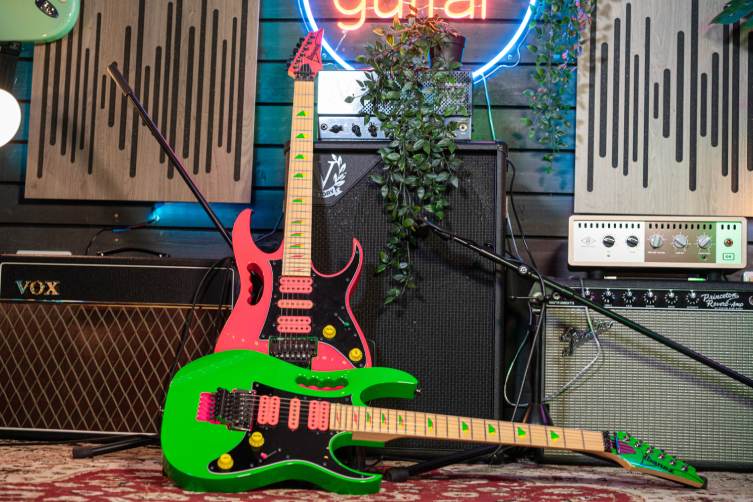
But they delivered. I received this guitar that was the JEM. It was what I had given them exactly. The things that they added that were really wonderful to me were the neck inlay, the floral pattern neck inlay. So that's when I said, okay, this is it. And what I had come to discover since that time, was what a good choice it was to go with Ibanez because they are a solid, solid, solid company. Several of the companies I was talking to at the time, just aren't around today, and Ibanez was eager to make this work and to make it right.
Now, when they had approached me then to do an endorsement deal, I still wasn't so keen on endorsing in the conventional sense. I just didn't want to feel confined, but they were going to make these JEMs for me, and I'm like, well, that's worth the price of admission, you know?
And then they said, ‘we'd like to make these for other people’. And I thought, well, I know this works for me, it's got all these things that I like. Maybe some other people will like it, because there's a lot of practical things. It was a fast, sleek instrument, it really was a player's kind of a thing at that time.
Plus there was an economic value to it: if you design an instrument and it sells, you make a royalty, so that was an allure. I was a working musician, you know, and still am! What I discovered about endorsements is, if you feel like you can retain your integrity, then it could work. If it’s a good company!
The Launch of the JEM (and the RG), the Quality of Ibanez
They launched the JEM, and to everybody's shock (laughs) it was very successful. And at that time that I was negotiating with them, there were certain deal parameters that I will say were absolutely extraordinary at that time, and still are. They really wanted to make this instrument popular, but it was very expensive and it was kind of quirky, because it had the handle and all this, so they asked me: can we make a lower end model that doesn't have the handle, and is different colours and stuff?
I thought, ‘yeah, okay, this deal is so good’, you know? (laughs) And they made the RG. So the RG is basically a JEM without the handle, haha, and then the RG… that blew up! At one time, and even perhaps now in various territories, it's the number one selling metal and rock guitar for years.
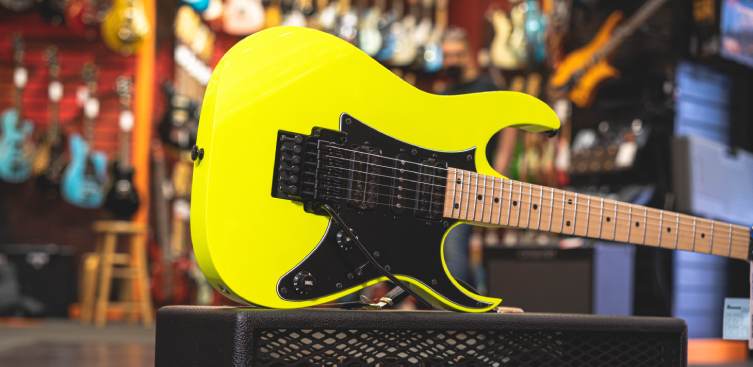
But when the JEM came out, it kind of struck a nerve because it had all of these little evolutions. And then through the years, I have to say, the JEM hasn't changed, but the appearance of it has changed many times. Little things, you know, pickups and certain accoutrements, but the basic bones of the guitar have remained intact.
And Ibanez: I just count my lucky stars because they’re such creative people there. They really support my crazy ideas, they take everything very seriously (laughs), and it's quality: they really focus on quality. I'm sure all guitar companies do their best, but you know, a company like Ibanez has a lot of skin in the game, so to speak. They take great care, and they're very creative. I would say something like, ‘okay, make me a JEM with a seventh string’ and bam, you know? There it was.
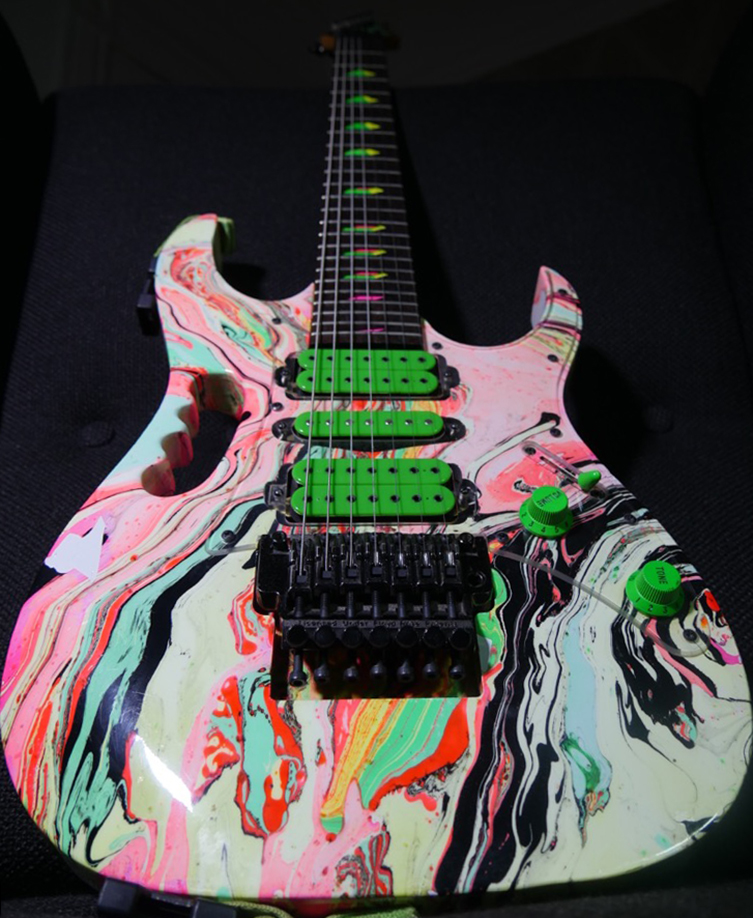
The Universe
And that was another game changer: very innocent at the time, just like the JEM. I didn't know these things! I kinda had a feeling: I was just about to do the Whitesnake record and I wanted something that set it apart from every other guitarist that may have played on it, or that has ever played, or was playing at the time and making those kinds of records. You know, you're allowed to think that way! (laughs) And I love thinking that way. What can I add? What's different? And I just thought, ‘I got it. I want a seventh string for that entire Whitesnake record. It's going to reshape the whole sound of Whitesnake!
I had one made and it became a model that was released, but it was kind of a novelty. A lot of people were interested in the beginning, but then the sales started to wane because it is kind of a novelty. I knew in the back of my mind, or at least I felt that while I was using that guitar, there were probably some younger kids that were not famous yet, or not making real records yet, that would be inspired by it.
I kind of felt it had a lot of potential to inspire in various ways, such as tuning that thing down and going (makes deep chug/djent noises), which…ta da!! It happened, you know?
And then there's the use in jazz. I remember walking into a club and I just saw this guy playing a Universe and he's just throwing jazz shapes, walking bass lines that you can't do with six strings, chord voicings…and I've even seen people play it classically, you know. But it's the metal guys that really brought it home, because the sales were waning to the point where Ibanez came to me and said, 'look, we're gonna discontinue this because it's only selling a couple a year’ or something. Normally I'd say ‘okay, we had a run, it was nice’. But something in me said ‘even if you're only selling a few a year, keep it going because it's not done yet’. I don't know why, but I was correct, (laughs), because then I remember - as the story goes - I was driving down the street and I heard this intense music on the radio, this metal that I had never heard and I knew: that's a seven string! It's because I could hear it, it's not like they're just tuned down six strings. I know that's a seven. Who the hell is this? And it was Korn. Once Korn blew up, they really ushered in that heavy sound of the seven string.
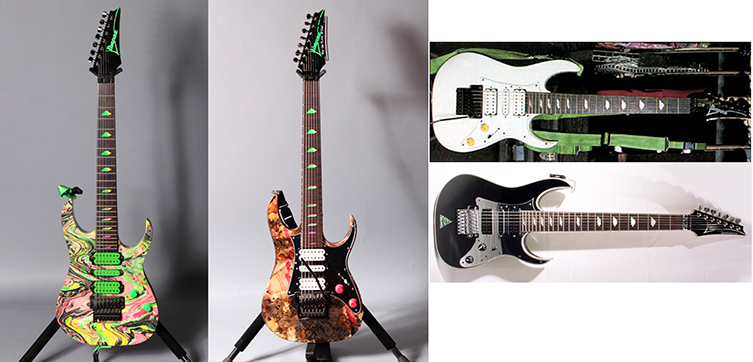
I did it on Whitesnake, but I didn't do it like those guys. I wasn't djenting, I wasn't doing something as obviously heavy as they were doing. I was using it more like a rock musician, not like the way they did with the intense stuff.
So then from there, that started to blow up. And just my run with Ibanez up to now, it's going to be 40 years in a couple of years, of just so many great, fun, interesting, kooky, crazy products, you know? The 7 string and, you know, I'd say, ‘yeah, okay, I'm shooting a David Lee Roth video. I need something really crazy. How about a giant heart-shaped guitar with three necks?’ And they're like, ‘one giant heart-shaped guitar with three necks coming up!’ (laughs) Oh boy, oh boy, it's nice being Steve! And then I get this thing, I'm like, what the hell do I do with this?
JEM Specifics
GG: That’s even more niche than the Universe, haha! So going back to the JEM, a lot of what we spoke about was the practicalities of what basically was missing from the electric guitars that you had. I wonder also, it always struck me that the JEMs are quite surreal, with the Monkey Grip, with the Lion's Claw, the Tree of Life, the exaggerated body shape and the colours. I'm just wondering, what was the kind of surreal vibe going on in terms of inspiration when you were thinking about what to do for it?
SV: Well, I was very young and naive (laughs), and I didn't really feel reverence for convention. So there was always…I don't know why, but some people have this, where you go to do something and you're not satisfied unless there's something in it that pushes your button. I apply that to everything I do: the music I make, every song I've ever recorded, I have to ask myself: okay, what is it that is different for you, and is showing your potential, you know? Like, where are you at your best? And where is it that you're doing something unique?
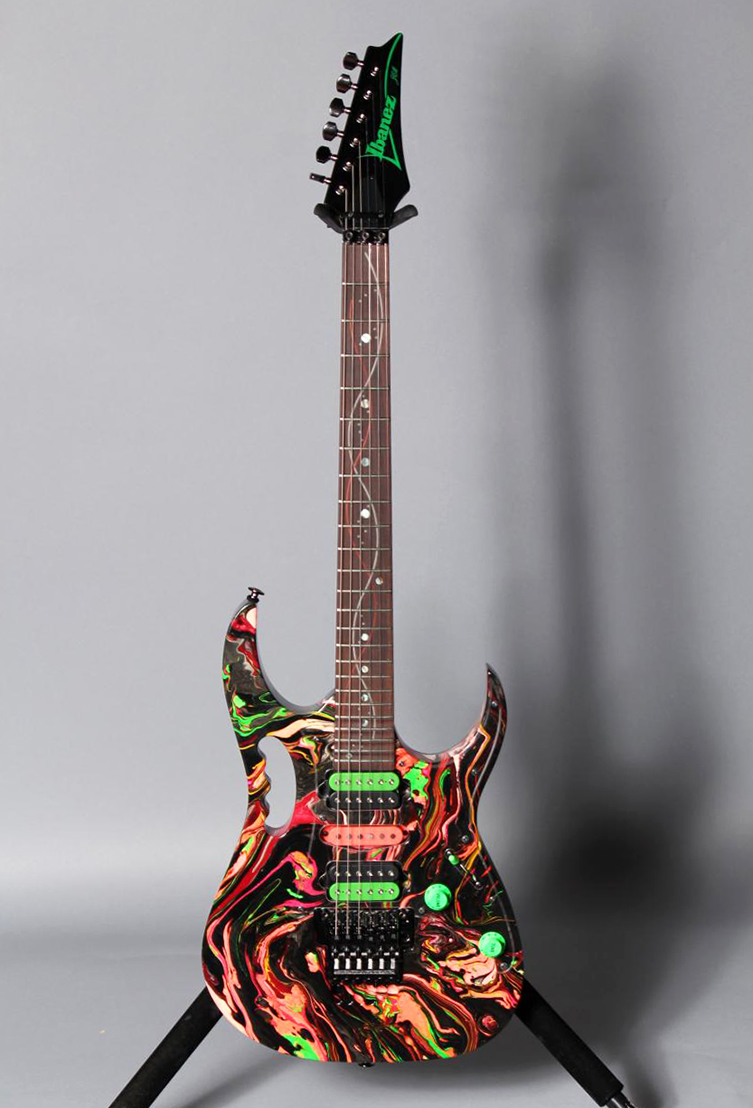
This Special Edition Swirl JEM actually contains Steve's blood in the finish!
Now, I miss the mark sometimes, but I know when I hit it too. It doesn't mean that it'll be picked up by anybody else. You’re first in line when it comes to accepting something. And I never thought that I could second guess what people want. I would try and I would just find I was sounding like other people. I would be copying or something. Any music that I've ever recorded like that never had a shelf life for me. I never go back and listen to it.
But the stuff that I feel like it's got that thing in it, that is a good representation of my potential, my DNA, my voice: those I love listening to. I suggest to anybody that is a creative - and everybody is a creative - to experiment with that concept: okay, so this is what it is, but what can be needed? How can this evolve? That's a great kind of a way to keep yourself open.
So when it came time to the JEM, I did the same thing. What can you do? What do you do with this? Okay, so you got the 24 frets you wanted, and you got the cutaway you want, you got the whammy bar you wanted. That's cool, but what else? (laughs) And it was, ‘I'm gonna put a monkey grip in it’. And I don't know why, but it's something I really wanted. I just thought it would be interesting and different, you know? And it's kind of cool, it's comfortable. And you can grab the guitar by it.
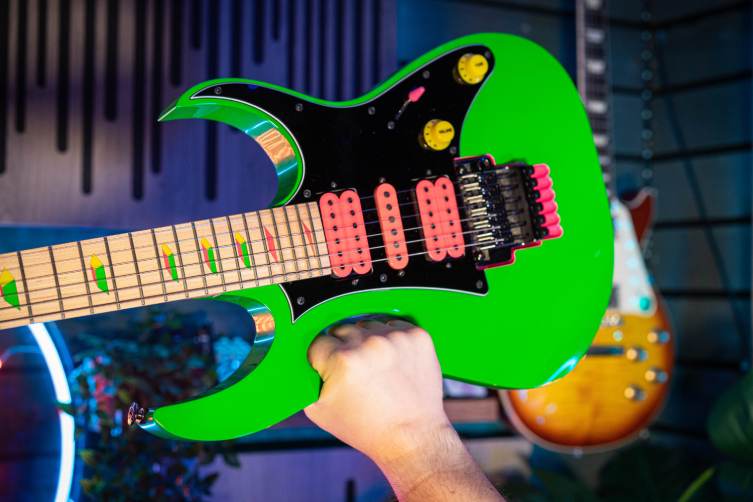
At first, I wanted it because again, it was a David Lee Roth video, and I wanted to be able to swing the guitar around!
GG: Hell yeah! But the cool thing about the monkey grip - I always thought - is that it made it really obvious from an audience's perspective, that it's a Steve Vai guitar, because nobody else has that.
SV: Yeah, and I knew that too. I knew that there were going to be unique features to the guitar that were probably going to end up being incorporated in other guitars, which was fine, that's how it works. These days, the pickup configuration is conventional. You can't buy a guitar with a whammy bar unless it's floating, like the first JEM. I mean, you can, but most guitars with that kind of intense performance, have got that, or at least the option for it.
And at the time I was with Dave Roth, and that was a very kind of ‘rock star, over the top’ kind of experience. It's just: excess, excess, excess, you know? Crazy clothes, crazy hair, crazy stage, running around, acting like badasses. (laughs) It was so much fun. And I thought, okay, what am I going to do? Am I going to go with a black guitar? Come on, you know? Red sells, red guitar! I'm not going to go with a red guitar. Yeah, but those are the ones that sell! That's fine. But I don't want red. What am I going to do? I want people to go, 'what the hell is that?' You know, I guess I'm that guy, you know?
GG: Hell yeah! Well, you know, it's worked for you!
SV: Fine, somebody's got to be it, you know? (laughs) That's when I thought of the day-glo colours.
Pyramids & Numerology
GG: Right, right! Now, I may be wrong about this: the disappearing pyramid inlays, were they the first thing that the JEM had, or did they come after the Tree of Life?
SV: They were first, I believe, and that was an Ibanez contribution, for sure. We discussed it, because I was very into pyramids and that kind of esoteric, New-Age stuff. So I think we had a discussion, and we said, can we make these pyramids?
GG: Right, okay. That also brings me on to another well-debated area. You see, I think a lot of people will read a lot of things into the pyramids being on the guitar, and also the all-seeing eye that was on the body of the Universe, inside a pyramid, surrounded by three sevens. That also leads me to the model numbering system for the JEMs. There are an awful lot of sevens in there, and I'm sure you're well into numerology, and seven is a very specific and significant number. Is that where you were going with those sevens?

SV: There was a period of time in my life where I went through learning about New Age stuff, and these esoteric principles. I was probably about 21, 22 when I first discovered this stuff. It was like finding a little treasure. There was this bookstore down the street called the Bodhi Tree, and they had all this metaphysical stuff: pyramids, Eastern philosophies, astrology, lucid dreaming, fasting, all religions, witchcraft, everything. I mean, I got all the Aleister Crowley and all the Eastern philosophies. I even read the Bible, you know, everything.
So part of that study that was fascinating at a particular period was numerology. So I started incorporating this stuff into my products.The number seven was a… I guess I was trying to distinguish the fact that I was born on 6-6-6. (laughs) (Steve’s date of birth is indeed June 6th, 1960!)
But, yeah, a lot of that stuff worked its way into the imagery of various records, and I still dabble with it a bit, but I have moved on from that kind of imagery and those kinds of esoteric things. They were valuable learning tools at the time, but for me they weren't answering the real questions.
Special JEMS: Floral, Acrylic 20th Anniversary
GG: Okay, great answer. I have some favourite JEMs over the years and with them are attached some myths, or maybe not so mythical! Of course, my favourite one of them all was the very first Floral JEM that came out.
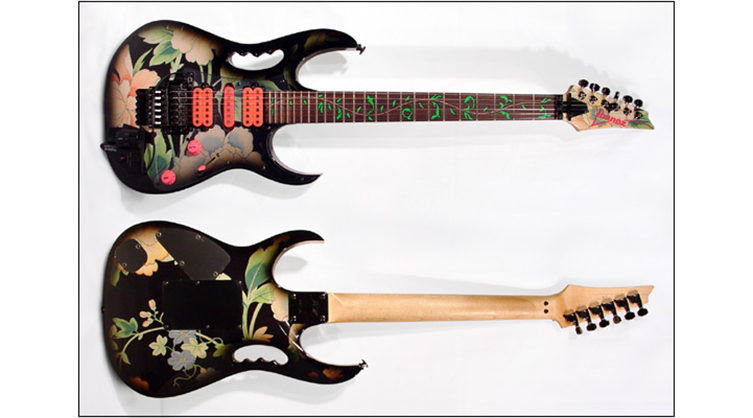
The story goes that it was your curtains that were actually used as a material underneath the finish. Is that true?
SV: Oh yeah! But it wasn't one of the first ones. It was an early model. And this is when you have a product, you want to keep it fresh and updated. We didn't decide to do that with any of the hard stuff like hardware. We changed out the tailpiece, changed out the pickups, but didn't change the body and didn't change the bones.
But with the skin, you can go crazy, you can do all sorts of things. So we're always looking for something interesting to do. I had these really cool curtains in our living room that my wife had found. And I thought, wow, that would make a great guitar. And, uh, it did (laughs) and that became the floral pattern.
GG: Haha, I love that so much! What a cool story. So, okay, on the subject of these cool, unusual JEMs, there’s another one. Well, there are loads, but this one in particular. (I show Steve a pic from the cover of his Steve Vai Anthology guitar TAB book). Was this the DNA model, or was that a different one?
SV: That's the acrylic model. It's an anniversary model. That was another one of those wonderful situations where Ibanez got creative. They brought that idea, because we're like, 'okay, we have this date coming up. It's a significant date. 20 years of the JEM'. The idea was to create a swirl, but to put the swirl inside of a see-through guitar and then if you pick up the volume knob, it lights up a green light that lights up the whole body. It's just fantastic.
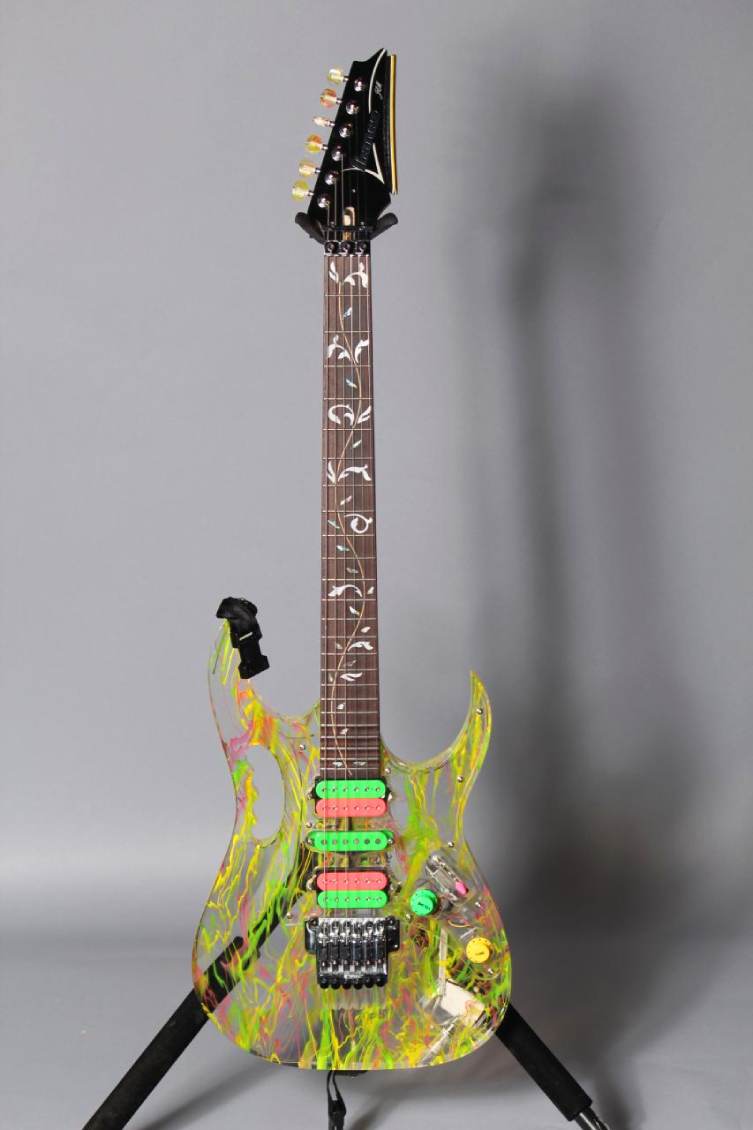
So this is kind of the fun thing you can do with a company like Ibanez. I say ‘I want an acrylic body that lights up green’, and they say ‘yeah, how about if we put these colours in it’? ‘Ok, yeah!’ (laughs)
Longevity of the JEM
GG: I love it! One thing I suppose it's really worth asking, certainly given what you were saying earlier. You already had your custom made JEM guitars prior to Ibanez being involved, and so you were happy: you were in a good position to be able to accept or turn down anybody if they weren't coming up with the goods, as far as endorsement went. Ibanez came up with the goods, and now here we are almost 40 years later. When that first JEM was released in 1987, you loved it obviously, but did you have any inkling that it was going to have such longevity in such an unchanged way?
SV: Not a clue. How do you know those things? I mean, I would be guessing. Now, I did feel that there were elements to the guitar that were movements forward for players, because it was a movement forward for me and I was a player. And they were simple, practical things: you know, if you're a Strat player, Tele player or Les Paul player. Most people, they use those guitars ‘work-wise’, you know? They're not virtuoso type players. I mean, there are virtuosos that play that kind of an instrument, but the JEM was more built towards those kinds of players that want to really explore their potential.
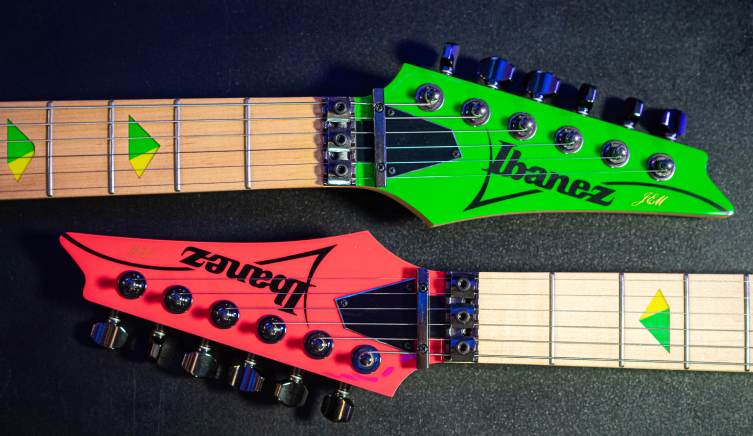
So it was built with an expansion in mind. Now, I didn't know I was doing that at the time. I was just like: “I want 24 frets and I want to be able to reach them and I want a whammy bar that does this and I want this pickup configuration and the jack should go here and, you know, the volume should go there. Why doesn't anybody make a guitar like that?” (laughs) And then, oof, there it was and I've never needed anything else. I've never been compelled to play another guitar. I play other guitars occasionally, but they don't feel like home. The JEM will always feel like home to me.
DiMarzio Evolution and EVO
GG: One of the things that I was thinking about was the DiMarzio Evolution pickups because they are very famous in their own right. I wonder, and please correct me if I'm wrong: I feel like they arrived at roughly the same time as the JEM. Were they developed alongside the JEM or were you already looking for a pickup with DiMarzio anyway?
SV: I can tell you my recollection. If you really want to know, you got to talk to Mike Messker or Larry DiMarzio. Working with Larry DiMarzio is as enjoyable as working with someone like Ibanez. Larry is a pioneer. He's interested in change, evolution. They’re an unbelievably supportive company, so I could experiment with all sorts of different things.
Back in the day, you bought a replacement pickup and you put it in - and you either liked it or didn't like it - or changed it out for another; you couldn't really have a custom pickup made. Not not that I knew of, unless you're working with a company that makes pickups, and are willing to do it for you. So, I remember at the time when it was put on the table that I could do whatever kind of pickup, I could work with Larry in designing any pickup. I had to really listen because I gave precious little attention to tone. It was more about performance, getting the chops together, you know? In the way of gear, I really turned a blind eye to a lot of that. But when I started working with Larry, he opened up the doors for experimentation.
"At the time I was with Dave Roth, and that was a very 'rock star, over the top' kind of experience. You just: excess, excess, excess, you know? Crazy clothes, crazy hair, crazy stage, running around, acting like badasses. It was so much fun!"
I remember that it was when the white JEM came out. So it wasn't the first round. We started experimenting. Now, when I do comparisons of pickups or microphones or cabinets or amplifier heads, I get very forensic, especially with guitars, because I can say, 'okay, send me five guitars, and put these different pickups in all of them'. But you'll get the guitars and the pickups will sound different. It's not always the pickups that add to the sound: it's the wood, it's where it was cut from the tree, all these elements go into the tone. So what I usually do is, I try to make it as much as ‘apples to apples’.
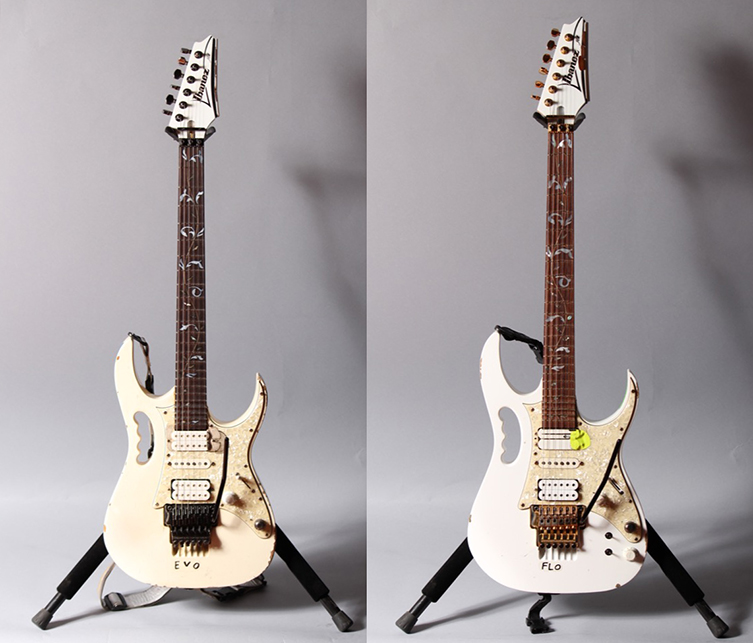
So when it came time to develop a pickup for that white JEM, also at that time I was very much into Southern California biker culture. I was a Harley guy and I had like seven harleys, you know? I didn't have a car, but I had seven harleys (laughs), I just like that culture. Through the years, Harley-Davidson would give different names to their engines; there was the Flathead, Knucklehead, Panhead, Shovel head, Evolution head and there's another one or maybe two more after that. I asked Larry to make me pickguards with these different pickup designs, like four or five of them, to be able to take the pickguard, put it in a guitar, record something, change the pickguard, put it in the same guitar, record the same thing. So this way, when you're listening back, you really are comparing apples to apples.
I ended up putting them in the guitar, but I couldn't tell the difference from the pickups because they don't have anything written or anything like that, so I wrote on them: I named the pickups after the Harley-Davidson engines, and I went with the Evolution. That was the pickup that I liked the best, so I called it Evo, the Evolution head, and I called the guitar Evo.
I wrote EVO on the guitar so I could tell the difference. There was something about that guitar I really liked. So that's EVO, and that's how the name came about.
The JEM Name
GG: There's a question that I just realised I've never asked and that I've never known. I wonder if you would supply the answer? It’s the JEM name itself, I don't know where it came from?
SV: Yeah, so I was born on Long Island, New York, and living right down the street from me was a kid named Joe Despagni. I knew him since I could see. In high school, we were best friends, were inseparable. All the rock and roll bands I was in in high school, Joe and I were just very close friends, we did everything together. He did all the lighting for the little bands I was in, he played guitar a little bit. And he was just like a partner in crime and a really fun friend, but very creative and very crazy, you know, crazy creative.
He started building guitars. They were crazy guitars! I mean, he'd take a piece of wood and just chop it up and then put these beautiful paint jobs and finishes on them. He started making me guitars and he made the Flame, he made the Lightning Bolt guitar. He made me a whole bunch and they're beautifully interesting and quirky, but they were hard to play, (laughs), they weren't really something that I would say: ‘this flame guitar is my main guitar’, you know?
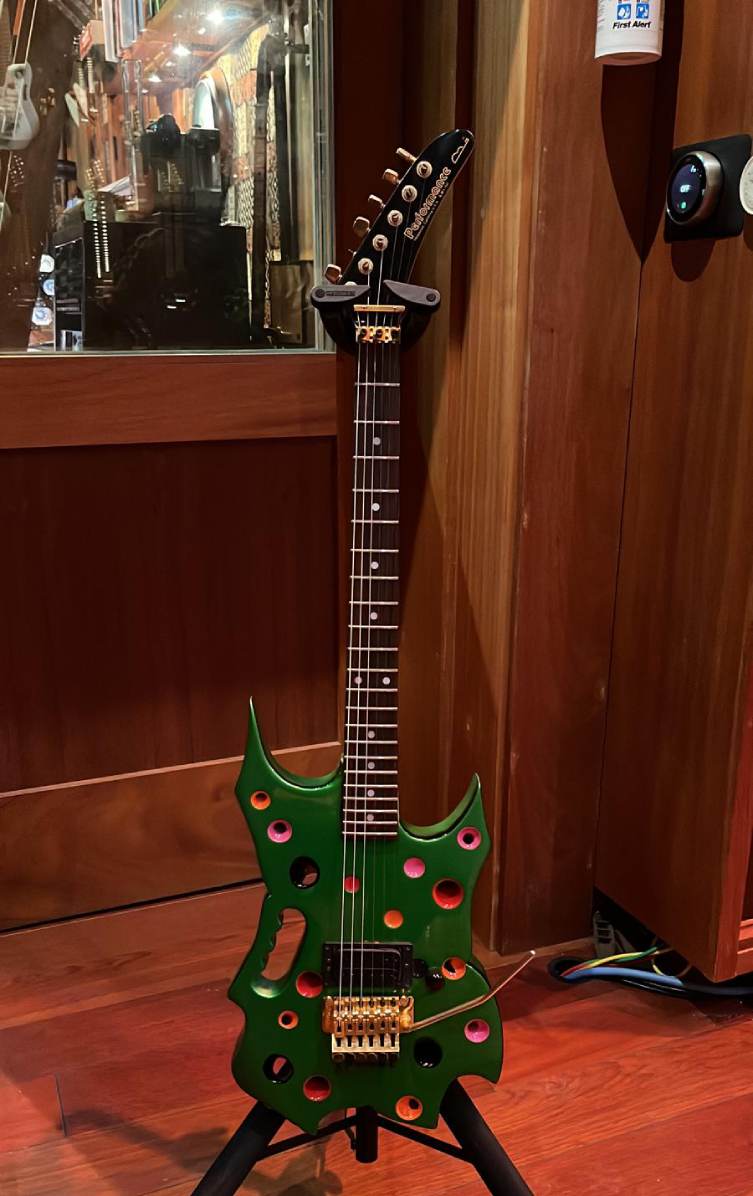
He wanted to start a company. Now, this was my thinking at the time. He wanted to start making guitars and he called them JEMs. right? I wanted to help him, so I started giving him money and helping him to get bodies and stuff like that. I thought that if I took the name, JEM, it would help promote his guitars. Because I didn't think then that it was going to do anything, a day-glo guitar with a monkey grip, you know? Joe was very happy about that, he actually put the first Monkey Grip in a guitar. It's that Swiss cheese guitar, he made me the Swiss cheese guitar. So Joe became a luthier, and he worked out of his garage in Florida, and he was a great fixer for all the guitar players in the town and he built some really beautiful instruments. So that's how the name came.
GG: Right, so it's a tribute to your friend, that's amazing! I love that.
What’s Next?
GG: I think we have managed to get through everything that I wanted to ask, Steve! Now, my final question: there ia the JEM, the PIA and the Hydra. What's next?
SV: Well, here's the thing about what's next. I don't try to figure it out because that never works. When I try to intellectualise what's next, it's trying too hard. And usually it's guesswork and it usually isn't so exciting.
The things that happened - when I look back at my career - that I see really worked were those things that came seemingly completely innocently. Like the JEM, in itself was very innocent: I wasn't trying to change the world. I didn't know if anybody else in the whole world would ever know about it and I didn't mind.
There's a light bulb that goes off in us when we get an inspired creative idea. And that's the case for everybody. Sometimes we don't trust it, sometimes we cover it up, sometimes we're in fear of it, but usually it's a very simple impulse that's meant for you, to take you in a direction for your personal expansion.
So that's why the JEM turned out the way it did for me because it was part of my innocent recognizing of something that made sense to me. Anything that I've done that has come out of that energy, usually works for me really well. And a lot of it would go unnoticed by anybody else, perhaps. It might be something like a simple riff. There's a song on Modern Primitive called, And We Are One.
I decided when I recorded that - it's a big long guitar solo - I wasn't going to do anything that wasn't unique for me, wasn't something that I could go: ‘Yeah. Oh, yeah. That's new, you're not going to improvise that, you know, this, this is worthy’. Now, others may not feel that way, but that's okay, you have to do it for yourself first. You always have to. You can try doing it for others first. Some people are good at that, I'm just not.
And so the next jam, whatever that might be, or the next crazy guitar or whatever, will have to come as a download, like they all did. It'll have to be one of those things that just goes, ‘oh’, and it can happen any time. You know, if I think about it like: ‘okay, what can I do? I need to come up with it now’, it usually doesn't work.
What I do is I plant the seed: I say, ‘I would like something…’ so I get a feeling. I don't know what it's going to be. But I don't have to because then I limit it. I limit the universe from supplying me with something that's much better than I could think up! (laughs)
GG: Right, right. Remaining open is more important than sort of like trying to force an idea.
SV: Yeah. I think so. But you gotta know how to open yourself. It really has to be out of simple innocence.
GG: Yeah, I absolutely understand what you mean by that. Because that's where all the greatness comes in; where Picasso’s Blue period came from, you know?
SV: Yeah!
That brings us to the here and now, with the JEM as popular as ever, and Steve about to embark on a thrilling history-making tour with Adrian Belew, Tony Levin and Danny Carey as BEAT. It hopefully goes without saying that I had a wonderful time talking to Steve about the JEM: as a fan of that guitar since I was a kid, you can believe that I felt every minute of that conversation!
I hope you enjoyed coming along on this ride with Steve and I. He’s a fantastic raconteur, and the amount of incredible music created on the JEMs is pretty astounding, so putting the story in one place like this is a pleasure and a privilege.
My huge thanks to Steve for his time on this, and his good spirit and vibes. Keep up with Steve on his socials and on the official Steve Vai website. Click the button below for all of our JEMs, PIAs and more, and thanks for reading this in-depth interview!
Browse our Ibanez Steve Vai Guitars


